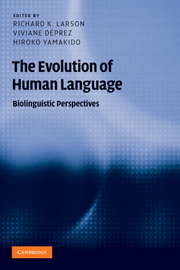Book contents
- Frontmatter
- Contents
- Figures
- Contributors
- Acknowledgments
- Introduction
- 1 The faculty of language: what is it, who has it, and how did it evolve?
- Part I Language architecture
- Part II Language and interface systems
- Part III Biological and neurological foundations
- 9 Plasticity and canalization in the evolution of linguistic communication: an evolutionary developmental approach
- 10 What is language, that it may have evolved, and what is evolution, that it may apply to language
- 11 The creative capacity of language, in what manner is it unique, and who had it?
- 12 Genetics and the evolution of language: what genetic studies reveal about the evolution of language
- Part IV Anthropological context
- Notes
- References
- Index
10 - What is language, that it may have evolved, and what is evolution, that it may apply to language
Published online by Cambridge University Press: 05 June 2012
- Frontmatter
- Contents
- Figures
- Contributors
- Acknowledgments
- Introduction
- 1 The faculty of language: what is it, who has it, and how did it evolve?
- Part I Language architecture
- Part II Language and interface systems
- Part III Biological and neurological foundations
- 9 Plasticity and canalization in the evolution of linguistic communication: an evolutionary developmental approach
- 10 What is language, that it may have evolved, and what is evolution, that it may apply to language
- 11 The creative capacity of language, in what manner is it unique, and who had it?
- 12 Genetics and the evolution of language: what genetic studies reveal about the evolution of language
- Part IV Anthropological context
- Notes
- References
- Index
Summary
Linguistics and biology are both witnessing such a rapid and ground-breaking progress that I think it wise to step back a moment and reconsider the very issue of the evolution of language at its roots. I wish to start with two real-life parables, drawing some important lessons from each. The first is from physics, the second from biology.
Parable 1. The Italian physicist Gabriele Veneziano is acknowledged to have been the first inventor/discoverer of the core idea behind string theory. Veneziano had not realized, back in 1968, where his idea was leading. Initially, his “dual resonance models” were only an elegant way of summarizing several apparently scattered facts and hypotheses and of solving some inconsistencies of the standard theory. In the fullness of time, it turned out that the consequence of that initial idea, and of the mathematical formalism used to express it, was that the world of elementary particles is the projection onto our four-dimensional space of modes of vibration and oscillation of microscopic uni-dimensional strings in a space with eleven dimensions. String theory is, for the moment at least, so many steps removed from experimental observation that its partial success has to be gauged by indirect confirmation of some of its secondary predictions. This is, understandably, far from deterring physicists, and work in string theory is in full swing.
- Type
- Chapter
- Information
- The Evolution of Human LanguageBiolinguistic Perspectives, pp. 148 - 162Publisher: Cambridge University PressPrint publication year: 2010
- 9
- Cited by



